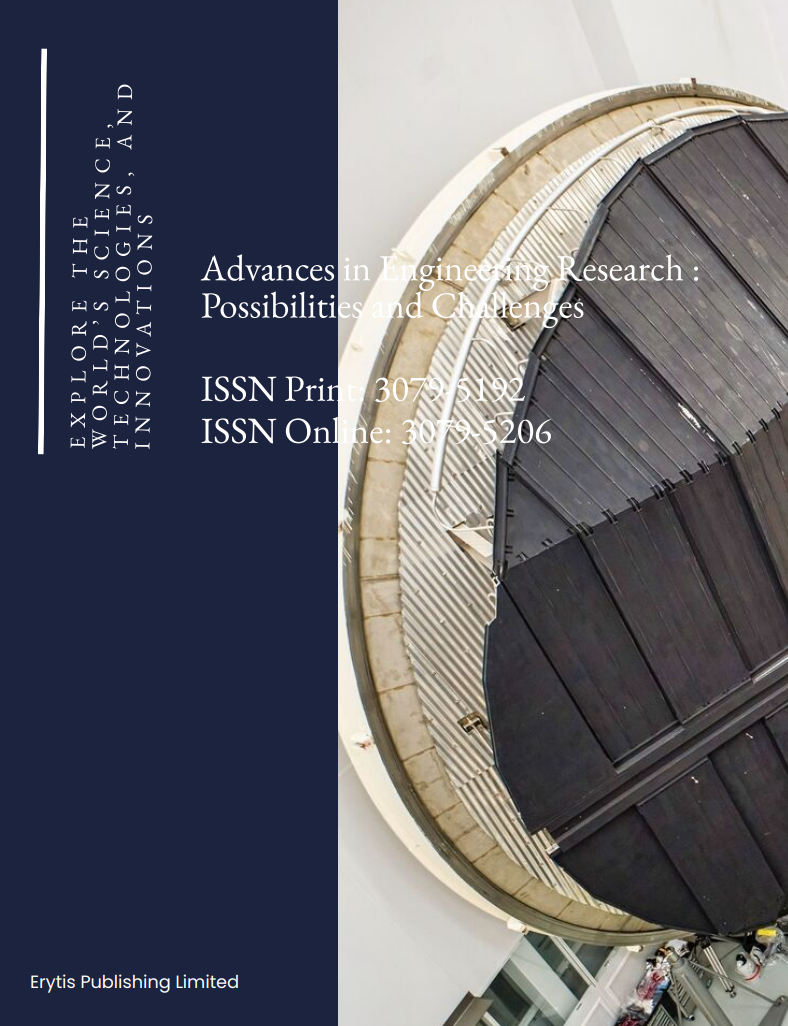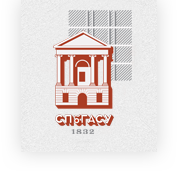Resource Allocation for UAV-Aided Disaster Emergency Communication
DOI:
https://doi.org/10.63313/AERpc.2002Keywords:
Unmanned Aerial Vehicle (UAV), Communication, Resource AllocationAbstract
This dissertation explores the utilization of Unmanned Aerial Vehicles (UAVs) for expanding wireless coverage in civilian applications, particularly real-time moni-toring, search and rescue, and disaster response. UAVs can function as aerial base stations, restoring connectivity during emergency cellular network outages. They can also augment existing ground infrastructure to enhance coverage and data rates for users. However, limited battery capacity necessitates periodic recharging of UAVs. This dissertation addresses the challenge of minimizing the number of UAVs required for continuous coverage of a designated area, considering the con-straints of recharging time, travel time, and the number of subareas encompassed by a single patrol cycle. Due to the inherent complexity of the problem, a graph-partitioning approach is proposed. The coverage graph is divided into cy-cles originating from the charging station, and the minimum number of UAVs needed to traverse such a cycle is determined based on the parameters above. An efficient algorithm is then developed to solve this optimization problem.
The dissertation subsequently investigates the optimal placement of a single UAV for minimizing the total transmission power required to ensure wireless cov-erage for indoor disaster victims. Two practical scenarios are analyzed, and effi-cient solutions are presented for each. Recognizing the limitations of a single UAV's transmit power, the dissertation further explores minimizing the number of UAVs needed for comprehensive indoor coverage. An efficient algorithm is pro-posed to address this challenge.
Finally, the dissertation examines the maximization of indoor wireless cov-erage using UAVs equipped with directional antennas. To prevent signal interfer-ence while operating on a single channel, non-overlapping coverage areas are pri-oritized. Two deployment methods are presented for UAV placement, considering coverage from one or both building sides. The results demonstrate that strategi-cally placing UAVs in an upside-down configuration can significantly improve total coverage compared to single-sided deployment.
References
[1] F. Librino, M. Levorato, and M. Zorzi, “An algorithmic solution for computing circle inter-section areas and its applications to wireless communications,” Wireless Communications and Mobile Computing, vol. 14, no. 18, pp. 1672–1690, 2014.
[2] S. Hayat, E. Yanmaz, and R. Muzaffar, “Survey on unmanned aerial vehicle networks for civil applications: A communications viewpoint.” IEEE Communications Surveys and Tutorials, vol. 18, no. 4, pp. 2624–2661, 2016.
[3] M. Mozaffari, W. Saad, M. Bennis, and M. Debbah, “Wireless communication using unmanned aerial vehicles (UAVs): Optimal transport theory for hover time optimization,” IEEE Transac-tions on Wireless Communications, vol. 16, no. 12, pp. 8052–8066, 2017.
[4] P. Bupe, R. Haddad, and F. Rios-Gutierrez, “Relief and emergency communication network based on an autonomous decentralized UAV clustering network,” IEEE SoutheastCon, pp. 1–8, 2015.
[5] M.Mozaffari, W.Saad, M.Bennis, and M.Debbah,“Mobile internet of things: Can UAVs provide an energy-efficient mobile architecture?” IEEE Global Communications Conference (GLOBECOM), pp. 1–6, 2016.
[6] AT&T Inc., “Flying COW Connects Puerto Rico.” [Online]. Available: http://about.att. com/inside connections blog/flying cow puertori (Accessed on May 27, 2018).
[7] AT&T Inc., “When COWs Fly: AT&T Sending LTE Signals from Drones.”[Online]. Available: http://about.att.com/innovationblog/cows fly (Accessed on May 27, 2018).
[8] Wikipedia, “Mobilecellsites.” [Online]. Available: https://en.wikipedia.org/wiki/Mobile cell sites (Accessed on April 18, 2018).
[9] M. Mozaffari, W. Saad, M. Bennis, Y.-H. Nam, and M. Debbah, “A tutorial on UAVs for wireless networks: Applications, challenges, and open problems,” arXiv preprint arXiv:1803.00680, 2018.
[10] Y. Zeng, R. Zhang, and T. J. Lim, “Wireless communications with unmanned aerial vehicles: opportunities and challenges,” IEEE Communications Magazine, vol. 54, no. 5, pp. 36–42, 2016.
[11] I. Jawhar, N. Mohamed, J. Al-Jaroodi, D. P. Agrawal, and S. Zhang, “Communication and net-working of UAV-based systems: Classification and associated architectures,” Journal of Net-work and Computer Applications, vol. 84, pp. 93–108, 2017.
[12] J. Zhao, F. Gao, Q. Wu, S. Jin, Y. Wu, and W. Jia, “Beam tracking for UAV mounted satcom on-the-move with massive antenna array,” IEEE Journal on Selected Areas in Communica-tions, vol. 36, no. 2, pp. 363–375, 2018.
[13] M. Mozaffari, W. Saad, M. Bennis, and M. Debbah, “Optimal transport theory for power- effi-cient deployment of unmanned aerial vehicles,” IEEE International Conference on Commu-nications (ICC), pp. 1–6, 2016.
[14] M. Mozaffari, W. Saad, M. Bennis, and M. Debbah, “Drone small cells in the clouds: Design, deployment and performance analysis,” IEEE Global Communications Conference (GLOBECOM), pp. 1–6, 2015.
[15] M. Alzenad, A. El-Keyi, F. Lagum, and H. Yanikomeroglu, “3-d placement of an unmanned aerial vehicle base station (UAV-bs) for energy-efficient maximal coverage,” IEEE Wireless Communications Letters, vol. 6, no. 4, pp. 434–437, 2017.
[16] M. Mozaffari, W. Saad, M. Bennis, and M. Debbah, “Unmanned aerial vehicle with underlaid device-to-device communications: Performance and tradeoffs,” IEEE Transactions on Wire-less Communications, vol. 15, no. 6, pp. 3949–3963, 2016.
[17] R.I.Bor-Yaliniz, A.El-Keyi, and H.Yanikomeroglu, “Efficient3-dplacementofanaerial base station in next generation cellular networks,” IEEE International Conference on Communica-tions (ICC), pp. 1–5, 2016.
[18] M. Mozaffari, W. Saad, M. Bennis, and M. Debbah, “Efficient deployment of multiple un-manned aerial vehicles for optimal wireless coverage,” IEEE Communications Letters, vol. 20, no. 8, pp. 1647–1650, 2016.
[19] E. Kalantari, M. Z. Shakir, H. Yanikomeroglu, and A. Yongacoglu, “Backhaul- aware robust 3d drone placement in 5g+ wireless networks,” IEEE International Conference on Communica-tions Workshops (ICC Workshops), pp. 109–114, 2017.
[20] M. Alzenad, A. El-Keyi, and H. Yanikomeroglu, “3d placement of an unmanned aerial vehicle base station for maximum coverage of users with different qos requirements,” IEEE Wireless Communications Letters, 2017.
[21] S. A. W. Shah, T. Khattab, M. Z. Shakir, and M. O. Hasna, “A distributed approach for net-worked flying platform association with small cells in 5g+ networks,” IEEE Global Commu-nications Conference (GLOBECOM), pp. 1–7, 2017.
[22] E. Kalantari, H. Yanikomeroglu, and A. Yongacoglu, “On the number and 3d placement of drone base stations in wireless cellular networks,” IEEE Vehicular Technology Conference, pp. 18–21, 2016.
[23] M. Zhu, Z. Cai, D. Zhao, J. Wang, and M. Xu, “Using multiple unmanned aerial vehicles to maintain connectivity of manets,” International Conference on Computer Communication and Networks (ICCCN), pp. 1–7, 2014.
[24] J. Lyu, Y. Zeng, R. Zhang, and T. J. Lim, “Placement optimization of UAV-mounted mobile base stations,” IEEE Communications Letters, vol. 21, no. 3, pp. 604–607, 2017.
[25] D. Yang, Q. Wu, Y. Zeng, and R. Zhang, “Energy trade-off in ground-to-UAV communi- cation via trajectory design,” IEEE Transactions on Vehicular Technology, 2018.
[26] D. Alejo, J. A. Cobano, G. Heredia, J. R. Mart ́ınez-de Dios, and A. Ollero, “Efficient trajectory planning for wsn data collection with multiple UAVs,” Cooperative Robots and Sensor Net-works, pp. 53–75, 2015.
[27] C. Wang, F. Ma, J. Yan, D. De, and S. K. Das, “Efficient aerial data collection with UAV in large-scale wireless sensor networks,” International Journal of Distributed Sensor Networks, vol. 11, no. 11, p. 286080, 2015.
[28] C. Zhan, Y. Zeng, and R. Zhang, “Energy-efficient data collection in UAV enabled wireless sensor network,” IEEE Wireless Communications Letters, 2017.
[29] H. Shakhatreh, A. Khreishah, J. Chakareski, H. B. Salameh, and I. Khalil, “On the continuous coverage problem for a swarm of UAVs,” IEEE Sarnoff Symposium, pp. 130–135, 2016.
[30] R. Miller, “Hurricane katrina: Communications & infrastructure impacts,” National Defense University, 2006.
[31] F. F. Townsend et al., “The federal response to hurricane katrina: Lessons learned,” The White House, Washington, D.C., 2006.
[32] E.M.Noam, “What the world trade center attack has shown us about our communications networks,” Global Economy and Digital Society, pp. 375–378, 2004.
[33] I. Dalmasso, I. Galletti, R. Giuliano, and F. Mazzenga, “Wimax networks for emergency management based on UAVs,” IEEE European Conference on Satellite Telecommunications (ESTEL), pp. 1–6, 2012.
[34] T. Ha, “The UAV continuous coverage problem,” Defense Technical Information Center Document, 2010.
[35] J. Wu, “Collaborative mobile charging and coverage,” Journal of Computer Science and Technology, vol. 29, no. 4, pp. 550–561, 2014.
[36] L.D.P.Pugliese, F.Guerriero, D.Zorbas, and T.Razafindralambo, “Modelling the mobile target covering problem using flying drones,” Optimization Letters, pp. 1–32, 2015.
[37] D. Zorbas, T. Razafindralambo, F. Guerriero et al., “Energy efficient mobile target tracking using flying drones,” Procedia Computer Science, vol. 19, pp. 80–87, 2013.
[38] E. T. Ceran, T. Erkilic, E. Uysal-Biyikoglu, T. Girici, and K. Leblebicioglu, “Optimal energy al-location policies for a high altitude flying wireless access point,” Transactions on Emerging Telecommunications Technologies, 2016.
[39] L. Gupta, R. Jain, and G. Vaszkun, “Survey of important issues in UAV communication net-works,” IEEE Communications Surveys and Tutorials, vol. 18, no. 2, pp. 1123– 1152, 2016.
[40] R. E. Korf, “A new algorithm for optimal bin packing,” National Conference on Artificial In-telligence and Innovation Applications of Artificial Intelligence (AAAI/IAAI), pp. 731–736, 2002.
[41] D. S. Johnson and L. A. McGeoch, “The traveling salesman problem: A case study in local op-timization,” Local search in combinatorial optimization, vol. 1, pp. 215–310, 1997.
[42] M. Wannberg, “The quadrotor platform: from a military point of view,” Swedish Defense Material Administration, 2012.
[43] R. D’Andrea, “Guest editorial can drones deliver?” IEEE Transactions on Automation Sci-ence and Engineering, vol. 11, no. 3, pp. 647–648, 2014.
[44] Sentinel, “SENTINEL+ Drone.” [Online]. Available: http://www.airbornedrones.co/ (Ac-cessed on May 12, 2016).
[45] H. Shakhatreh, A. Khreishah, and I. Khalil, “Indoor mobile coverage problem using UAVs,” IEEE Systems Journal, 2018.
[46] H. Shakhatreh, A. Khreishah, and B. Ji, “Providing wireless coverage to high-rise buildings using UAVs,” IEEE International Conference on Communications (ICC), 2017.
[47] H. Shakhatreh, A. Khreishah, A. Alsarhan, I. Khalil, A. Sawalmeh, and N. S. Othman, “Efficient 3d placement of a UAV using particle swarm optimization,” IEEE International Conference on Information and Communication Systems (ICICS), pp. 258–263, 2017.
[48] A. Al-Hourani, S. Kandeepan, and A. Jamalipour, “Modeling air-to-ground path loss for low altitude platforms in urban environments,” IEEE Global Communications Conference (GLOBECOM), pp. 2898–2904, 2014.
[49] Ericsson, “Ericsson report Optimizing the indoor experience.” [Online]. Available: https://www.ericsson.com/res/docs/2013/real-performance-indoors.pdf (Accessed on Oc-tober 23, 2016).
[50] Nokia, “In-Building Wireless: One Size does not fit all.” [Online]. Available: https: //insight.nokia.com/infographic-building-wireless-all (Accessed on October 23, 2016).
[51] Cisco, “Cisco Service Provider Wi-Fi: A Platform for Business Innovation and Revenue Gen-eration.” [Online]. Available: https://www.cisco.com/c/en/us/solutions/ collat-eral/service-provider/service-provider-wi-fi/solution overview c22 642482. html (Accessed on October 23, 2016).
[52] H. R. Facilities, “Using High-Power DAS in High-Rise Buildings.” [Online]. Available: high-risefacilities.com/using-high-power-das-in-high-rise-buildings/ (Accessed on August 18, 2017).
[53] Amplitic, “Coverage Solution for High-rise Building.” [Online]. Available: https://www.amplitec.net/products-2-coverage-solution-for-high-rise-building.html (Ac-cessed on October 23, 2016).
[54] S. Zhang, Z. Zhao, H. Guan, and H. Yang, “Study on mobile data offloading in high rise building scenario,” IEEE Vehicular Technology Conference (VTC Spring), pp. 1–5, 2016.
[55] M. Series, “Guidelines for evaluation of radio interface technologies for imt-advanced,” In-ternational Telecommunication Union Report, no. 2135-1, 2009.
[56] T.Imai,K.Kitao,N.Tran,N.Omaki,Y.Okumura,andK.Nishimori,“Outdoor-to-indoor path loss modeling for 0.8 to 37 ghz band,” IEEE European Conference on Antennas and Propagation (EuCAP), pp. 1–4, 2016.
[57] J.L.BentleyandR.Sedgewick, “Fastal gorithms for sorting and searching strings,”ACM- SIAM symposium on Discrete algorithms, pp. 360–369, 1997.
[58] R. S. Sutton and A. G. Barto, “Reinforcement learning: An introduction,” MIT Press, Cam-bridge, MA, vol. 1, no. 1, 1998.
[59] J. Kennedy and R. Eberhart, “Particle swarm optimization,” IEEE International Conference on Neural Networks, vol. 4, pp. 1942–1948, 1995.
Downloads
Published
Issue
Section
License
Copyright (c) 2025 by author(s) and Erytis Publishing Limited.

This work is licensed under a Creative Commons Attribution 4.0 International License.















